
49 minute read
Better bull better calf
by AgriHQ
James Dallinger is an equity partner in a 220ha Waikato farm that is aiming for zero bobby calves. James with his 580-cow herd.
Combination for success
By Anne Boswell
Maungatautari dairy farmer James Dallinger has admirable goals when it comes to his herd’s breeding strategy – and his use of technology ensures the cows are on the mating platform at the optimal time, every time.
James Dallinger, an equity farmer on his 220ha Waikato farm, is striving to reduce the number of bobby calves born to the 580-strong herd, while increasing genetic gain.
An electrician by trade, he is always interested in what technology is available to the dairy industry. In his third season using Senztag CowManager, it has allowed him to pinpoint the cows’ heats with precision.
Full AI mating lasts 10 weeks, which he hopes to reduce to nine weeks going forward.
His Samen representative Victor Kooter has categorised the herd to three bull teams based on conformation: Red team, Blue team and Beef; the latter being undesirable to breed from.
“With this coding system we should end up with a more uniform herd,” James says.
He spends the first four weeks mating for replacements but if a good cow comes on heat in the fifth week, they will still mate her for a replacement.
After that, all mating is to beef – the low end of the herd not worth breeding future replacements from.
Sexed semen goes to the better producers in the herd that have historically held to their first mating, and have no health issues in the current season that could compromise conception.
Samen Belgian Blue short gestation genetics are used to ensure all beef calves are of a good quality.
“Sale prices for the Belgian Blues have been great so far,” he says.
“We have definitely noticed the demand for them is getting stronger year-on-year.
“With help from Trudy at Dairy Beef Collective, we have been matched with a buyer for the coming season, so all our

beef is taken care of – it is a great step in the direction of our journey to zero bobbies.”
All of the good, strong Friesian bulls calves born are sold as four-day-olds.
James says historically the herd produces between 130-140 replacements, but that is by mating everything for replacements and keeping everything.
“This season, with the new regime, we have kept 150 replacements with the use of sexed semen,” he says.
“In the coming season we may have more, as our R2 heifers have been put to AI to enhance our genetic gain.”
He is happy to witness genetic gain in increased efficiency, fertility and longevity, rather than a breeding worth number.
Now three seasons into using CowManager, he is enjoying making decisions based on the data generated by the software.
He uses two of the system’s three modules – health and fertility – which provide accurate information about the herd via an ear sensor which can be placed into the cow’s ear in a single action.
Any suspicious behaviour – measured by movement, variance in body James Dallinger’s one-man dairy shed is highly automated.
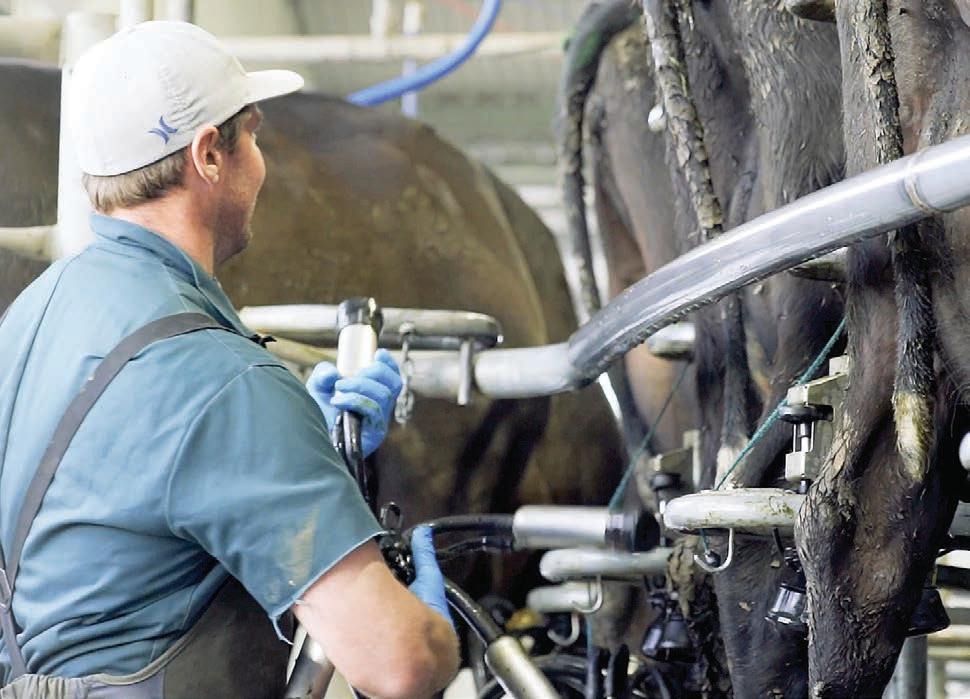
James Dallinger receives real-time herd data on his mobile phone with Senztag CowManager. temperature or a change in eating and ruminating patterns – is tagged within the system and then compared against the herd or group average for that particular time of day, or any longer period being analysed. Over time, the system builds up a stronger picture of each animal and becomes increasingly accurate. James uses the health module yearround, identifying potential health issues before they escalate. “This software is so powerful, especially around calving time where we are really monitoring cows,” he says. “CowManager is great for identifying metabolic issues and treating symptoms before they become a problem.
“Being able to identify issues and treat them sooner means there are fewer down cows.”
The fertility module is where he can get the most out of the premium genetics he invests in, lowering insemination costs and increasing pregnancy rates.
When a cow becomes agitated and delivers movement patterns synonymous with oncoming oestrus, the system verifies actual oestrus by comparing the temperature variation against the current average of the herd. It then compares recent movement activity against the patterns most symbolic of oestrus behaviour.
It is this process that guarantees the system provides accuracy in helping farmers identify the absolute best time to inseminate individual animals.
“As we’re using more sexed semen, pinpointing the timing of heats is more crucial than ever,” he says.
“With CowManager, the precision of mating is increased; the efficiency of the software makes it cost-neutral.”
Cows that are alerted in CowManager for heat reasons can be requested for drafting via Protrack Draft Integrate in the next milking.
All cows on heat are drafted into a pen, onto the platform and mated.
“It’s just easy,” he says.
“The technology allows us to maintain the one-person operation of our 50-bail rotary shed. It’s so easy to use, anyone can step in.
“Staff spend less time in-shed and more time at home with their family.” n
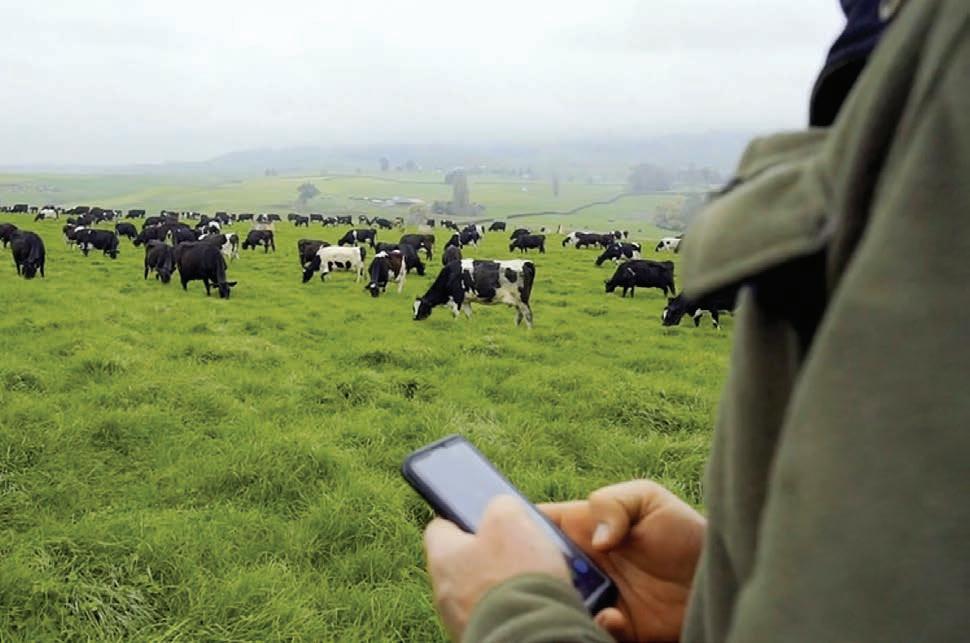
Best of the best
New Zealand Hereford Selection Indexes are designed to make life easier for bull buyers.
For buyers of registered
Herefords, selection indexes put a convenient dollar value on the breeding values according to the situation that bull will be used.
Hereford Selection Indexes have been developed to assist farmers make a “balanced” bull-buying decision, in a similar way that the BW (breeding worth) is calculated for your dairy herd.
NZ Herefords recently identified three markets which they believe best meet commercial bull buyers’ requirements. • Hereford Prime Index – aimed at commercial beef farmers to use over their mature aged cows, with moderate to medium birth, good carcase traits, including IMF and positive fats suited to moderate mature cow size, offering good fertility and days to calving. Refer to the website for specifications: • Beef Heifer Index – ideal for the beef farmer looking for calving ease for heifer mating, but also some focus on maternal traits so heifers can be kept, and growth traits, so steers can be finished. Suited for bulls to be used over Hereford heifers and also Angus, and other beef herds looking for hybrid vigour and replacement heifers offering fast growth and calving-ease. • Dairy Beef Index (replacing the Dairy
Terminal Index) designed for dairy farmers looking for registered Hereford bulls to use over their mature aged dairy cows, to sire calves which are born easily and grow quickly.
Dairy Beef Index is a new index but broadly similar to the superseded Dairy
Terminal Index. Changes from the Dairy
Terminal Index include an increased emphasis on improving intramuscular fat (marbling) at the expense of a slight drop in growth. There was also an increased emphasis upon reducing birthweight.
How to rank bulls using selection indexes on online catalogues
Incorporating selection index The Dairy Beef Index is designed for dairy farmers looking for registered Hereford bulls to use over their older dairy cows.
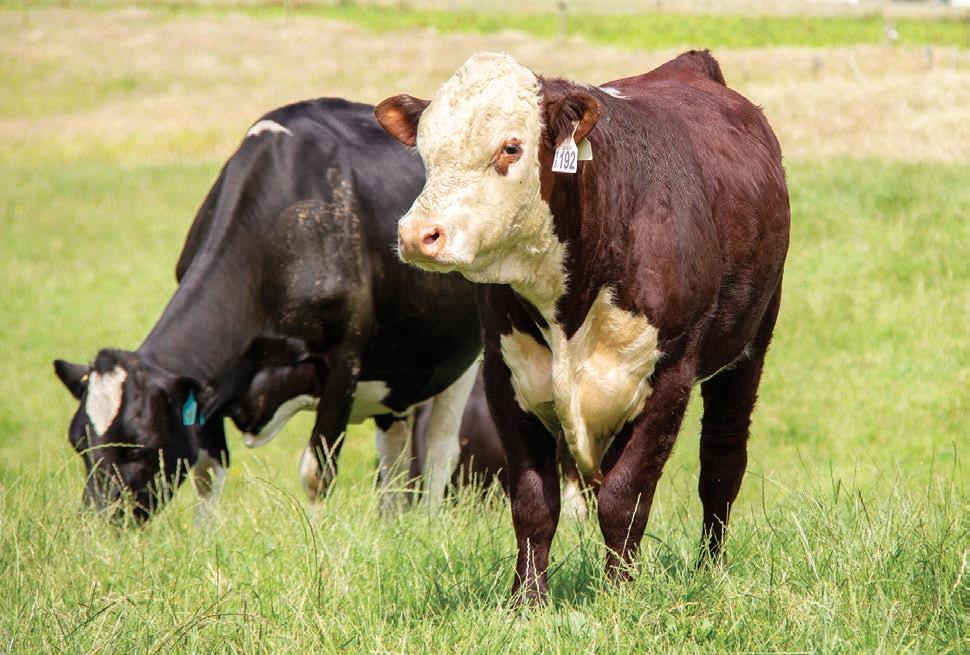
information into buying decisions takes all the hard work out of trying to decide how much emphasis you need to put on individual EBVs when determining which bulls you want to purchase. The recommended strategy for selecting bulls is to complete the following steps: 1. Identify the selection index of most relevance for your commercial herd. 2. Rank animals on the selection index.
This can be done using the NZ
Herefords website www.herefords. co.nz by accessing the red drop-down menu titled Online Search on the left of your screen and clicking on Sales and Semen Catalogue. Then select the sale catalogue of interest to you. Once you have done that, click on Show All
Entries followed by Show All EBVs. By selecting the index you are interested in you can then rank the animals in a catalogue that you have selected. 3. Consider the individual EBVs of importance. Selection indexes could be viewed as an initial drafting gate, but it is important to look closer. Two bulls could have a similar dollar index value but quite different EBVs. For example, one could have more growth and another bull might have more marbling.
Which traits are important to your breeding objectives?
If you know the EBVs of previous bulls you have bought, you can use this to help your decision-making. If there is a particular part of your system that is letting you down, then you need to focus on the EBVs affecting it directly. For example, if you are disappointed with pregnancy scanning, keep a close eye on the Days to Calving and Scrotal EBVs. If you are happy with your growth rates but you are missing out on quality premiums, then look at the IMF EBV.
Consider other traits of importance that aren’t included in the genetic evaluation. Structure, bull fertility, bull docility, genetic conditions and pedigree are all important considerations in this step.
All selection indexes are reported as an EBV, in units of net profit per cow mated ($) for a given production/market scenario. They reflect both the shortterm profit generated by a sire through the sale of his progeny, and the longerterm profit generated by his daughters in a self-replacing cow herd, where applicable. n
MORE:
Detailed information regarding each Selection Index can be accessed through the NZ Hereford website.
Bruce Turpie’s zero bobby calf policy aligns with his gold elite status under Synlait’s Lead with Pride scheme.
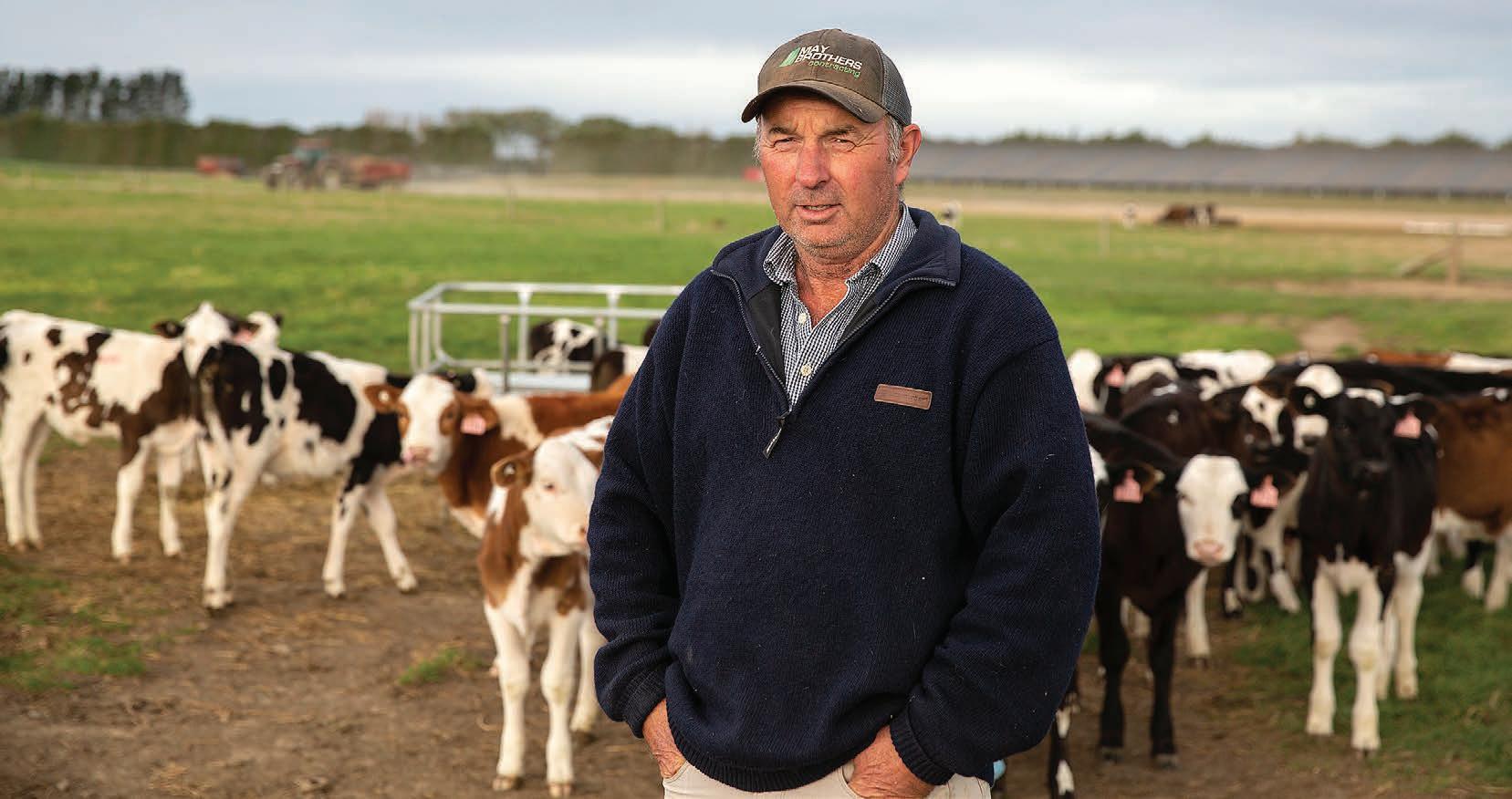
Zero bobbies
By Tony Benny
Using Samen beef genetics over the herd, a Canterbury farmer is reaping the rewards of saleable calves and no longer has bobby calves.
Thanks to an innovative breeding policy that includes using sexed semen to get replacement heifers and beef breeds over the other cows, large-scale Canterbury dairy farmer Bruce Turpie sends away zero bobby calves.
Turpie milks 1600 cows on a 500ha dairy and cropping property near Methven and has an additional 130ha at Geraldine. He milks year-round fulfilling a winter contract with Synlait and calves four times a year to keep the operation running.
Spring calving runs for six weeks, then there’s a three-week calving in December, six weeks in February-March, followed by three weeks in May. He says while the system sounds complicated, it’s actually pretty simple.
“We’re trying to keep the mating and the calving reasonably tight, so we’re not doing it every day of the year or anything,” Bruce says.
“We just keep heifer replacements from the spring and the autumn mating so it doesn’t get too complicated with having different sized heifers running around.”
He aims for annual production of 600kg MS/cow, and says sometimes high-producing cows aren’t ready to breed as soon after calving as farmers would like, so he gives them a second chance to get in-calf once they’ve put on more condition.
“If we have a 25% empty rate for each of those calvings, we’re very happy with that. They’re probably going to be some of the higher-producing cows that don’t want to get back in-calf until they’re 14 or 15 months apart,” he says.
“They don’t get too many holidays but they do get one, when they’re allowed to breed 15 months apart.”
Bruce reckons New Zealand farmers are sometimes too ruthless culling empty cows.
“That’s exactly the problem with the NZ seasonal system. Everyone is culling their best-producing cows because they’re not ready to breed. It can take 80 days for some of these high-milk cows to reach the balance point as far as putting condition back on again after calving.”
After a period of building up numbers to reach the current herd size, he says they no longer need as many replacement heifers, so each year only the top third of his cows are mated to dairy breeds, with the rest going to beef bulls.
“We’ve got milk meters and anything that’s not doing more than 30 litres production per day doesn’t get the opportunity to give us a heifer calf so they’ll be AI inseminated with either Wagyu or a Belgian Blue followed with Wagyu bulls,” he says.
The half beef-breed offspring are sought-after, with the Wagyus in demand from as young as one-week-old through to weaning at 90kg. The Belgian Blues are in demand too, but this year he’s finishing some on the Geraldine property.
“We‘re just doing a wee trial at the
moment to take some through to finishing and see how long that takes, and to see how the numbers stack up,” he says.
For the dairy herd replacements, sexed semen is used, alongside heat-detecting electronic collars on the cows so mating can be timed perfectly to maximise conception.
“You’re breeding them closer to ovulation than you do with conventional straws. With the electronic collars you get two lines on the computer screen that basically show the right hours to breed so we breed twice-a-day for about 12 days each time,” he explains.
Bruce says he’d like to “toughenup” his Holstein herd so he’s adding American Holstein, Swedish Red and French breed Montbéliarde genetics to the mix.
“Breeding is my favourite thing really. I don’t have time to put cups on or anything in the shed, we employ people to do that, and I spend hours on the genetic side of it,” he said.
A positive side effect of his breeding policy, Bruce says is he no longer has any bobby calves to deal with, which ties in nicely to his gold elite status under Synlait’s Lead with Pride scheme.
“It’s not compulsory to have no bobbies, but they do expect you to explore every avenue to reduce them as much as you can and we just don’t want to be putting hundreds of bobby calves on the truck,” he says.
He believes pressure against bobby calves is growing in foreign markets.
“NZ farmers perhaps need to think a bit harder about some of these things, but realistically we can’t have every farmer in the country keeping all their calves because there’s just nowhere for them to go.”
Nevertheless, he’s pleased to have found a way to stop the bobby truck from calling at his place and make the most of every calf born on his farm. n
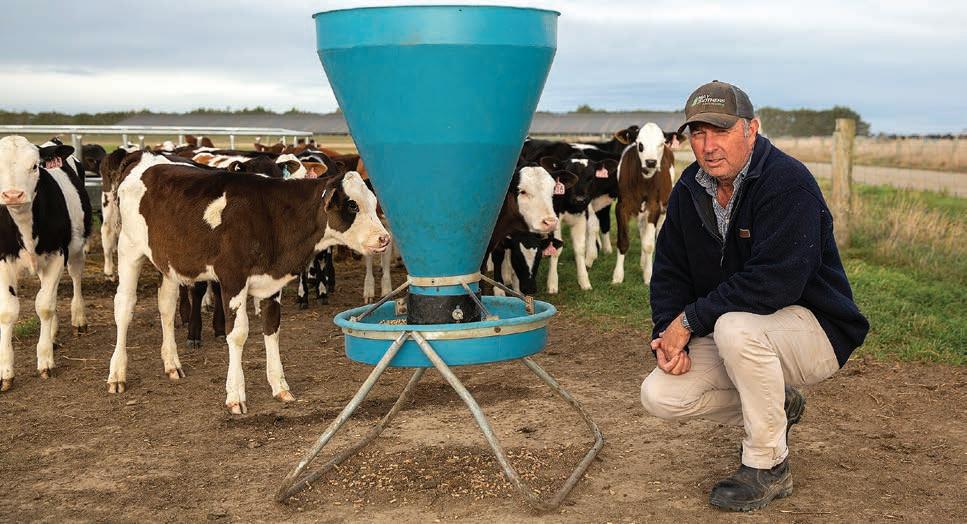
Canterbury farmer Bruce Turpie milks 1600 on a 500ha farm, which milks year round and calves four times a year.
Accuracy No Less.
24/7 reliable data at your finger tips.
The patented ear sensor technology relays the collected information to a series of routers placed around your farm, giving you 24/7 reliable data at your finger tips. CowManager is cloud based, which allows you to access your data from wherever you are.
For More Information www.senztag.co.nz 0800 220 232
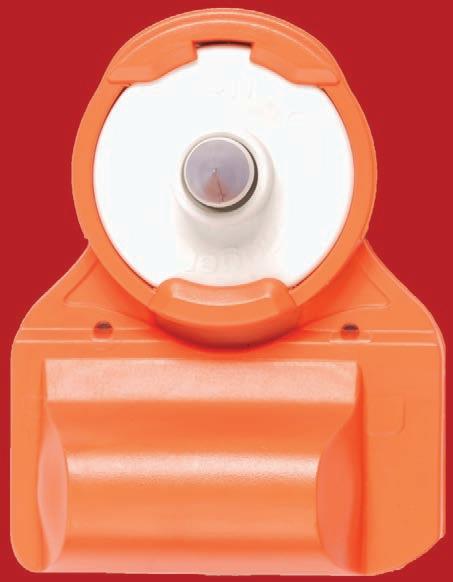

Purposeful lives
By Anne Boswell
Owl Farm’s tailored breeding programme sees it make good on its goal to achieve breeding with purpose.
AWaikato school’s demo farm’s “purposeful lives” strategy is much more than a nod to animal welfare, as they look to reduce the number of bobby calves.
The introduction of a Sexed Semen/ Wagyu breeding programme has seen a Cambridge dairy farm reduce the number of bobby calves born, increase profitability, and minimise their carbon footprint.
Owl Farm, a 125ha farm owned by and located on the grounds of St Peter’s School in Cambridge, milks 405 crossbred cows producing 1200kg MS/ha.
Demonstration manager Jo Sheridan says the St Peter’s School community, as owners of the farm, are engaged in the decision-making process on-farm – and one widely-held principle led to the creation of an updated breeding strategy.
“One outcome our community wished to see was an increased number of purposeful lives – or fewer bobby calves – so we incorporated that into the farm’s breeding strategy as an overarching goal,” Jo says.
Farm manager Tom Buckley says in 2019, the team launched a Sexed Semen/ Wagyu breeding programme that aimed to reduce the number of bobby calves born while creating a marketable, valueadded product.
Of the 718 semen straws used in the 2019 mating, 182 were Wagyu/short gestation length Hereford, 172 were liquid sexed semen and 112 were short gestation length (SGL) dairy, in addition to the 252 straws of conventional semen.
SGL dairy was used between weeks 7-12 of mating, and sexed semen was used on the top 75% of the herd selected on BW, health status, age (2-8 years) and those who had a pre-mating heat.
“We mated the best cows on the day that match the above criteria,” Tom says.
When the team reviewed the 201920 year, they were pleased to see they were on the right trajectory: they had increased profit by $4240 and reduced bobby calf numbers by 31% as a result of the Sexed Semen/Wagyu mating plan.
“Based on the success of the 2019 season’s mating and calving programme, we decided to continue with the Sexed Semen/Wagyu programme,” Jo says.
“With the reduced replacement
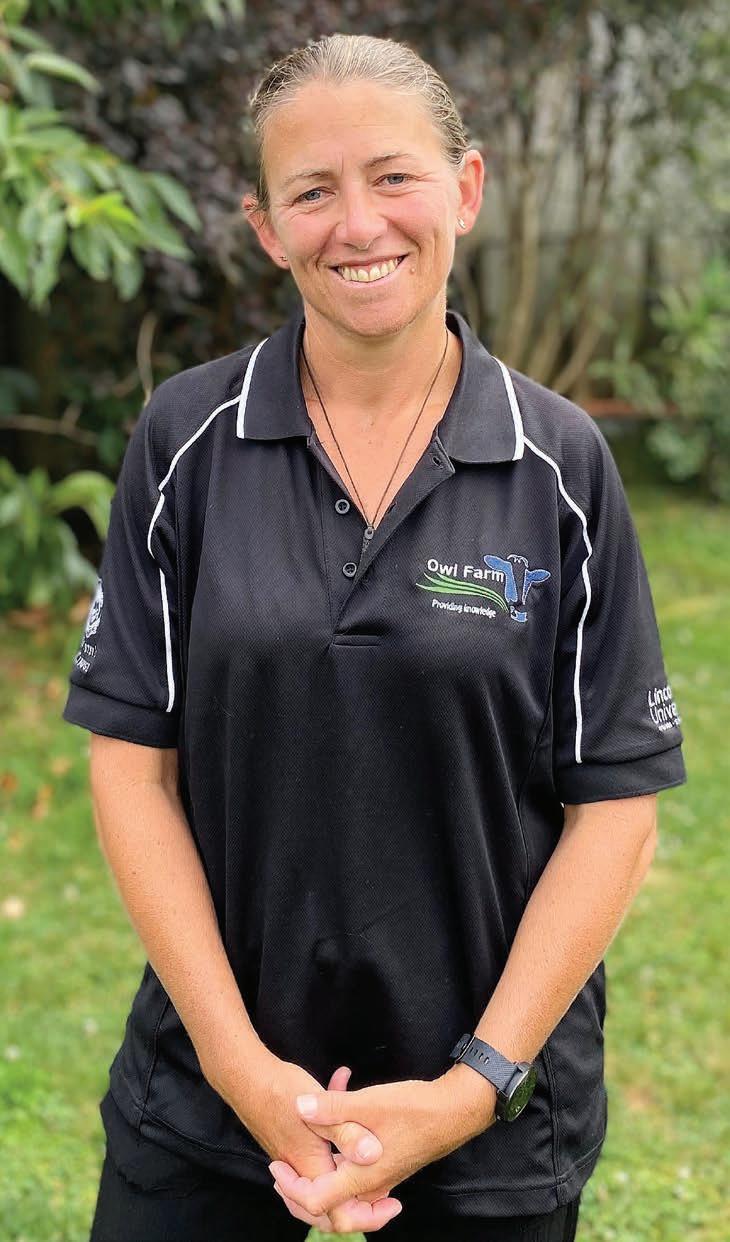
Owl Farm demonstration manager Jo Sheridan says the St Peter’s School community goal is to see an increased number of “purposeful lives”.
Jo Sheridan

Tom Buckley and LaArni Bayquin working together to care for the calves in the early days. Warm dry facilities are important for healthy calves.
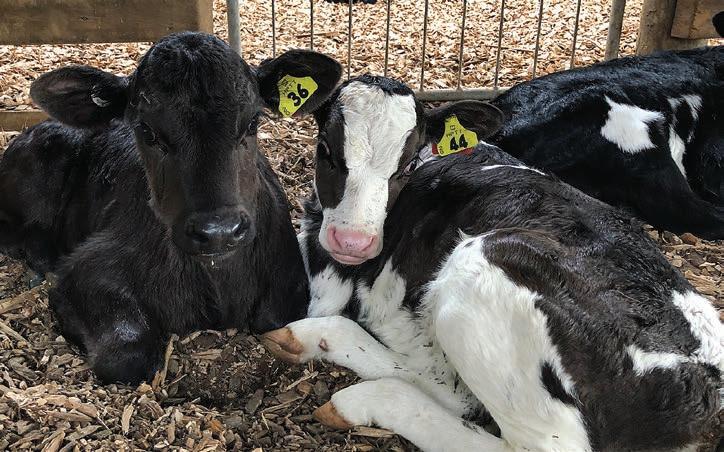
numbers (90) needed to rear, we decided to synchronise the R2s to ensure we strive towards our goal of the herd being in the top 5% national BW.”
On September 23, 2020, yearling mating synchronised blanket insemination commenced with 30 straws of Kiwicross sexed semen and 71 straws of Premier Sires Kiwicross A2/A2, before running bulls 10 days after AB mating.
Milking herd mating commenced September 25, using eight sexed semen Kiwicross straws per day until October 14. Premier Sires A2/A2 Kiwicross matings were completed on the first day to the top 50% of the herd who were either unable to be mated to sexed semen or synchronised as non-cyclers. Wagyu or Angus were mated to the balance of the herd.
KEY STATS
2019-20 season: • 74% 6-week in-calf rate • 13% not-in-calf rate • 84-day mating duration • 70-day calving period
From October 15 to December 15, Wagyu or Angus semen was used until all straws were gone, and then SGL Kiwicross semen was used until the mating end date.
Owl Farm had 350 Wagyu straws available to use before they switched to SGL semen.
The Sexed Semen/Wagyu mating plan has made a significant contribution to the farm’s goal of purposeful lives.
Overall, Owl Farm has seen a steady decline in bobby calves from around 275 in 2018, to around 165 in 2020.
The number of high-BW heifer calves born has increased from 90 to 135 in the last three seasons. Owl Farm targets a replacement rate of 21% - selling the balance to improve the national herd – as rearing fewer replacements minimises the farm’s carbon footprint and greenhouse gases while ensuring all animals lead a productive life.
By regenerating replacements from the top 75% of the herd, the herd has experienced accelerated genetic gain. With a BW of 212, the herd is in the top 6% nationally, teetering on the farm team’s aim of entering the top 5%.
The Wagyu beef aspect of the mating plan has also increased the value of the calves born.
In 2020, around 70 Wagyu calves were born. They were reared on-farm for 21 days before fetching a contract rate of $165/calf – with an additional bonus of $6.50/kg above 35kg, heavier calves have the potential to earn a little more.
“Wagyu prices are consistent and can be built into the farm’s budget, unlike Hereford calves,” Tom says.
“Hereford calves born to crossbred cows can be a little smaller, and we’ve found that if they don’t get to the first sale of the season, they are not much more valuable than a bobby calf – there is less risk with Wagyu.”
Jo says with calving due to start on July 3, the team is confident the Sexed Semen/Wagyu breeding plan will continue to generate positive farm business improvements.
“The running of the farm reflects the St Peter’s School community’s goal of 100% purposeful lives, and we continue to do that by generating high BW replacements for the herd and breeding valuable beef cross animals.” n
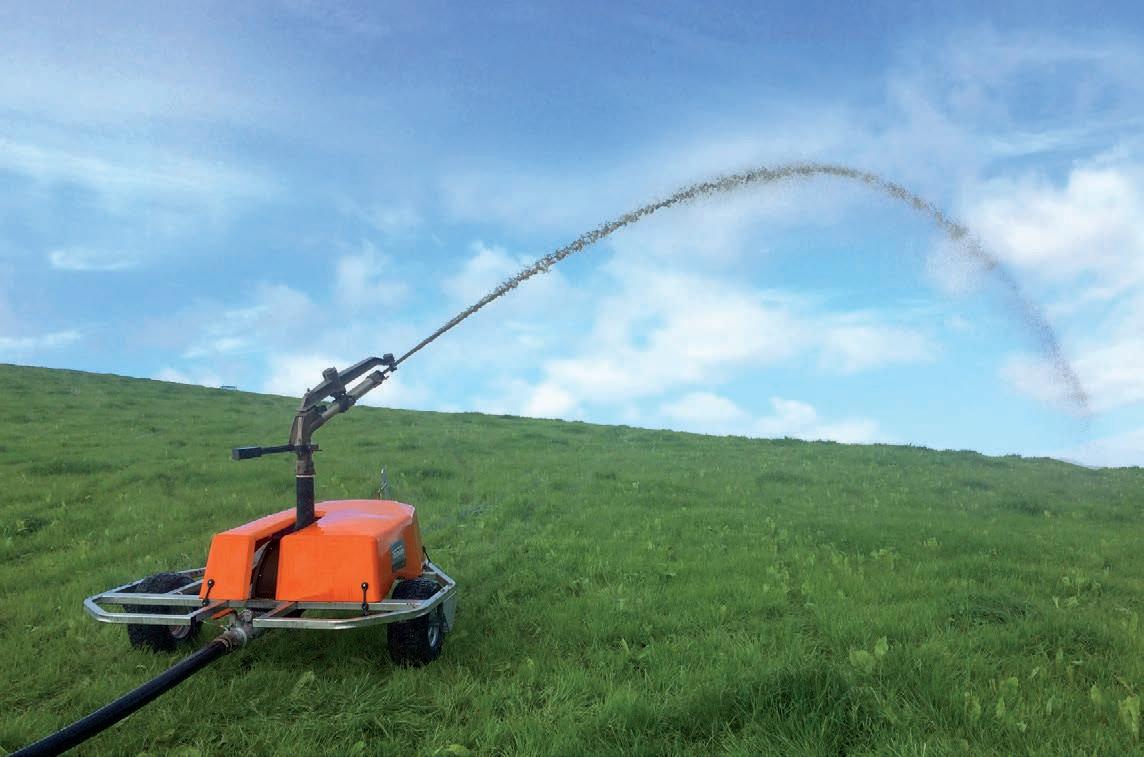
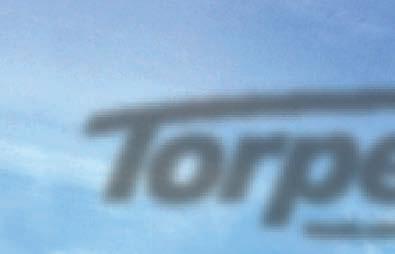

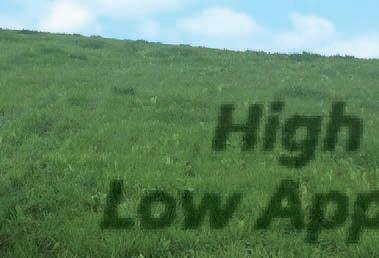
Mike Cranstone of Riverton Hereford stud is one of two that makes up the Ezicalve brand supplying dairy farmers with bulls that have easy-calving genetics.
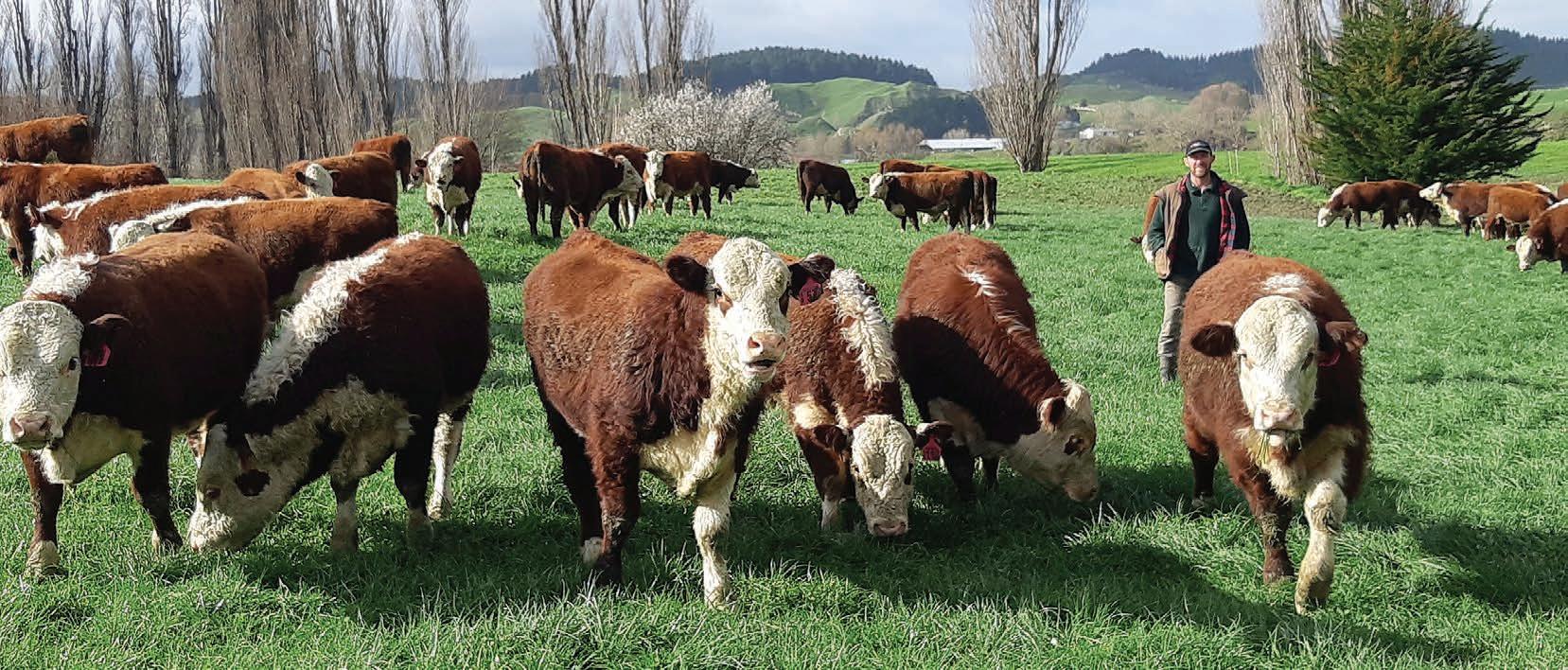
Breeding bulls for dairy
By Ross Nolly
Bulls that have low birthweight and ease of calving traits are a good option for farmers looking to use Hereford over their heifers.
The recent trend to move away from bobby calf production has led to a burgeoning interest in using low birthweight, easy-calving beef bulls over dairy heifers and for tailing the milking herd.
Buying a random beef bull can be a gamble. Many dairy farmers now prefer to use beef bull breeders who specialise in breeding bulls with low birthweight and easy-calving genetics.
Mike and Cath Cranstone own Riverton Herefords stud and, along with William Morrison’s Ardo Herefords, make up the Ezicalve Hereford brand. Their aim is to provide dairy farmers with Hereford bulls predominantly selected for low birthweights and calving ease, while maintaining high growth rates. Annually, more than 30,000 calves from Ezicalve bulls are reared and finished.
Riverton Herefords stud sits in Whanganui’s Whangaehu Valley. The farm was originally a 470ha property bought by his great-grandfather in 1905. The couple have farmed the property for about 25 years.
“The original 470ha has been in the family for four generations and runs a Hereford herd. My great-grandfather established the Hereford stud in 1906 and it has provided a great foundation for the following generations. It’s the oldest Hereford stud in the country,” Mike says.
“We now farm 1800ha, built around the original 470ha. We’re proud to continue and build the business on what previous generations have developed.”
The property is a mixture of medium to hard hill country supported by fertile river flats. They calve 650 cows that compete with 6500 ewes. The cows are not only part of the bull breeding business, they support the breeding ewes and work hard maintaining pasture quality for the breeding ewe flock.
They feel that Herefords are the ideal breed for their own farming business and as breeding bulls for heifer mating for the dairy and beef markets.
“We’ve concentrated on easy calving and low birthweight for the past 30 years, with the focus on breeding ideal bulls for dairy clients. We’ve got calving ease and low birthweight traits consistent through the herd for many generations now.
“A large herd allows us to put large selection pressure on growth and other important traits. We carefully record information and make selection decisions constantly focused on our objective. Calving ease is a non-negotiable trait,” he says.
The first hurdle any potential bull must pass before it’s used in their herd is that they must have confidence in its calving ease. This has been a consistent focus for three decades, and that consistency is paying off in results.
All calves are weighed and tagged at birth, and 200 yearling heifers are mated each year. This allows all potential sires to be quality tested, proving their genetics before being used over the main herd.
“Selecting stock with a balance of traits is the challenge and enjoyment of breeding. The more generations stacked upon each other, focused on a consistent objective, allow you to reliably entrench those traits throughout the herd,” he says.
When the Cranstones and Morrisons launched the Ezicalve brand they wanted to promote the differentiation that their herds are clearly focused on calving ease for heifer mating. Their
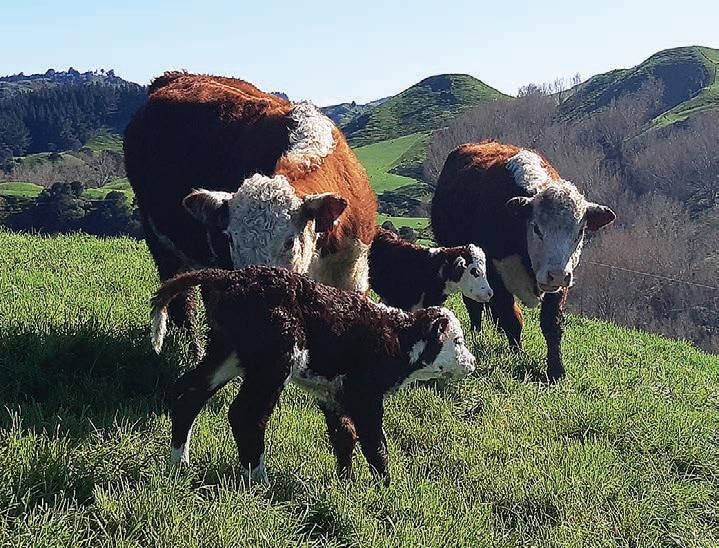
The original Wanganui farm was 470ha, which has grown to 1800 hectares and calves down 650 cows.
clients trust their heifers and cows to the Ezicalve bulls and that responsibility is taken very seriously.
“Ezicalve bulls help reduce bobby calf numbers on dairy farms. It’s exciting to be able to offer one solution to that industry issue. We’re getting increasing enquiries from new clients who want to be ahead of the pack. Many are very proud that they no longer produce any bobby calves,” he says.
“It’s very cool to speak to a new client and know that you can add some real value by taking a bobby calf of marginal value to a top beef animal. It’s a challenge for the industry that’s not going to be easily fixed, but our genetics may provide one tool that helps.”
Dehorning calves is another contentious issue, and genomics is helping them to identify and breed homozygous polled bulls, which will consistently remove all the horns off their dairy cross progeny.
Knowing that your heifers and cows aren’t going to need calving interventions lowers the stress on dairy farmers during a stressful time of year. While the primary focus for Ezicalve bulls is easy calving and low birthweights, they also focus on short gestation to offer a complete package.
“We appreciate that a dairy farmer’s main focus is to get their heifers to calve as easily as possible and get back in-calf again. Their focus is milk production, not producing beef calves. So we must provide clients with the confidence to use our bulls to add value to their calf crop and provide the industry with a quality animal,” he says.
Most of the Cranstones’ bulls are sold as yearlings. Yearling bulls are 400kg and are ideal to use over yearling heifers and are big enough to use over cows.
“The cost of buying a two-year-old bull and only using it for one season can be prohibitive. Many of our clients are rolling over half of their bull team each year. Their bull teams are usually made up of 50% each of yearlings and two-year-olds.” he says.
They place a huge amount of emphasis on bull temperament at all times of the year. “The last thing you want is a bull beating its chest at the gateway,” he says.
“This is the 28th year that we’ve held our sale and we’re very fortunate to have a loyal client base. We place a very high emphasis on client support. It is fun getting our clients back on-farm, it’s a very enjoyable day. Many of our client relationships span a number of generations.
“When a farmer uses one of our bulls over their expensive heifers and cows, they’re trusting their livelihoods with us. We take that responsibility very seriously. It’s rewarding to add value to their farming business.” n
• Riverton Ezicalve Herefords: Thursday, September 23 • Ardo Ezicalve Herefords: Tuesday, September 28 * There about 400 bulls for sale between the two studs.
Mike Cranstone
SALE DATES
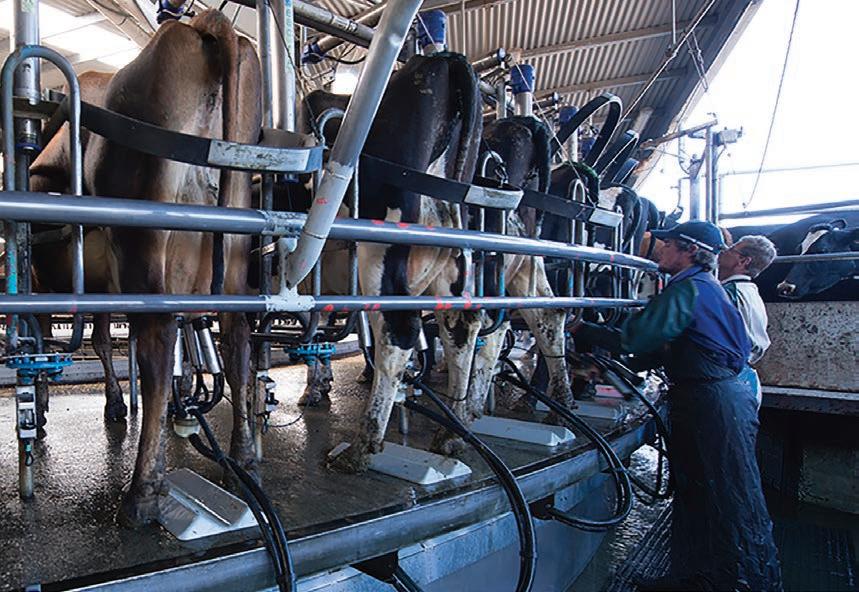

Rethinking genetic selection
CRV New Zealand’s latest bull team offers more than just a high index, responding to farmer demand for genetic solutions to tackle challenges around the environment, herd efficiency and animal welfare.
CRV has introduced a wide range of new sires to its portfolio for 2021, with 22 newly graduated sires and 15 new genomic InSires, in addition to 13 new sires in its global portfolio.
The bull team offers options for highindexing, high-production A2 sires, which CRV expects will sell out. The company’s 2021 dairy-beef FertaBull offer now includes Angus and Belgian Blue, in addition to Hereford.
“Sustainable dairy farming cannot be achieved by index alone,” CRV product manager Peter van Elzakker says.
“Farmers need to look more broadly than production figures and select genetics that will help them achieve their breeding goals based on the needs of their farm business.
“This year’s bull team reflects the confidence farmers have in using genetic solutions, such as genomic (InSires) sires and sexed semen, when making breeding decisions.
“Improving a herd’s environmental efficiency continues to be a priority for many farmers.”
Breeding with CRV sires can also help farmers meet the requirements of dairy company payment programmes, like Fonterra’s new Co-operative Difference initiative.
“LowN Sires is an option many farmers are considering, particularly given our innovative trait sires are first and foremost excellent sires in their own right,” he said.
NZAEL’s Ranking of Active Sires (RAS) list represents the top-ranking proven sires in New Zealand. The bulls are ranked according to the National Breeding Objective (BW). To qualify they need to have at least 70% reliability.
CRV’s top-ranking sire is Puketawa King Connacht JG – first place in all breeds and Jersey. Connacht is a member of the LowN team offering fantastic longevity, low SCC and strong capacity.
Glen Leith Quigley ET S2J – fourth place all breeds and Jersey – and Crescent Leo Dominator – eighth place, and ninth, all breeds – are new graduates offering excellent efficiency.
In the crossbreeds, Arkans Gurkha J9F7 is ranked number seven on the RAS list. Gurkha offers exceptional efficiency and excellent health traits.
Both traits are highly sought-after by farmers.
In the Friesians, last year’s graduate Lennan continues to rank highly and is joined by new graduates Alias and Baz. Alias and Baz are in our LowN team, with Lennan in our Facial Eczema (FE) team, offering more than just high indexes.
CRV has a number of top-ranking new InSires.
In the Crossbred team, Connolly Car Shark offers the full package – exceptional efficiency, excellent longevity (plus 450 days) and strong capacity. Friesian Alcameno MG Roadster S1F is high on both the Efficiency and Health index, a winner for production, as well as being suitable for farmers on a once-aday milking system. A very efficient and healthy Jersey is Lynbrook Floyd Gibson ET, which will produce long-lasting, very capacious and highly productive daughters.
CRV offers a wide team of its highest index sires, with semen available as sexed or conventional. Examples of the calibre of sires available as sexed are Arkans Gurhka J9F7 for Crossbreeds and Crescent Leo Dominator for Jerseys. Ambzed Grand Lennan S1F is an excellent Friesian option. n

CRV product manager Peter van Elzakker says farmers need to select genetics for their herd to suit their farms rather than just production.
CRV’s topranking sire is Puketawa King Connacht JG who is number one for all breeds and Jersey. Connacht is a member of the LowN team offering fantastic longevity, low somatic cell count and strong capacity.
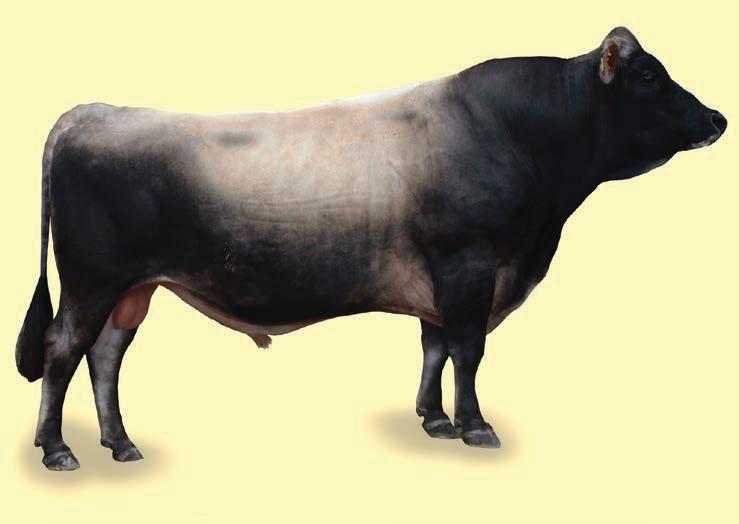
Pioneering dairy cow
By Ross Nolly
The first cows to be introduced in New Zealand more than 200 years ago were Shorthorns and although they are still being farmed here, numbers are diminishing as farmers prefer other breeds but the Shorthorns have plenty going for them.
When the first pioneering farmers arrived in NZ, the cattle breed that came with them was the Shorthorn – probably the most influential cattle breed in the global history of agriculture.
Shorthorns have a magnificent NZ heritage. Most early pioneer self-sufficient, subsistence farming homesteads and bush cabins would have had a Shorthorn cow supplying them with milk, butter and cheese.
Those cows were dual-purpose animals that provided milk and wonderfully marbled meat. They were the self-sufficient house cow from farms carved out of the bush that eventually established NZ’s dairy industry.
Ross and Jo Soffe milk 360 cows, including 90 Milking Shorthorns on their 160ha (130ha effective) farm situated at Tariki in Central Taranaki. However, there are some NZ milking herds that are 100% Shorthorn. Shorthorn numbers are particularly strong in Manawatu and the South Island.
Soffe is a director of the New Zealand Milking Shorthorn Association and began farming Shorthorns in 1994. He is also a member of the Friesian, Ayrshire and Guernsey associations. The Soffe’s Milking Shorthorn Oliver Woods Stud is named after his great-great-grandfather.
“I’ve always been interested in doing something a bit different and to discover how other breeds compared in the dairy herd. When farming at Tikorangi we bought some neighbouring land and thought it was the perfect time to do something different. So we bought six or seven Milking Shorthorn cows the first year, and just kept buying more,” Ross says.
Shorthorns are renowned for their ease of calving and Ross says “they can push out some pretty big calves without any problems at all”. He finds that they have far less calving issues than the other breeds in his herd.
The breed has a good temperament as any bad traits were bred out many years ago. Shorthorns tend to have a good constitution and great longevity in dairy herds. He has seen a great photo of a 23-year-old Milking Shorthorn cow that won a dry cow class at the 1948 Canterbury Show.
Shorthorns have good legs and feet, an important trait considering the longer distances that need to be covered on many modern farms.
“A few years ago I analysed our hoof treatments statistics. We were experiencing an exceptionally wet year and correspondingly the number of lame cows had risen. The Shorthorn’s numbers rose too, but still at the typical 50% lower rate compared to the other breeds,” he says.
“They don’t mind walking up and down the hills or back and forth to the shed. They’ve retained the hardiness of their ancestors, which was built on natural attrition. “Their TOP numbers for udders and conformation are just as good as the rest of the other breeds. Their fertility rate is also top-notch.”
He has heard many anecdotal instances of people with a lactose intolerance being able to drink Shorthorn milk. The New Zealand Milking Shorthorn Association is prioritising A2 bulls for marketing.
The breed’s milk has a high proteinto-fat ratio, which seems custom-made for cheese-making and micro-dairying. Their milksolids produce a high cheese and butter yield per litre of milk, and the milk’s larger fat molecules are perfect for artisan micro-dairies.
The association runs its own bull breeding scheme in association with Semex, a Canadian-based company with access to North American genetics.
“We source our bulls from our association members who don’t receive any payment for their service. It’s all done for the benefit of the breed. The Shorthorn semen is marketed through Semex, but the farmer retains ownership of the bulls,” he says.
“We can source pure Milking Shorthorn Genetics from the US and
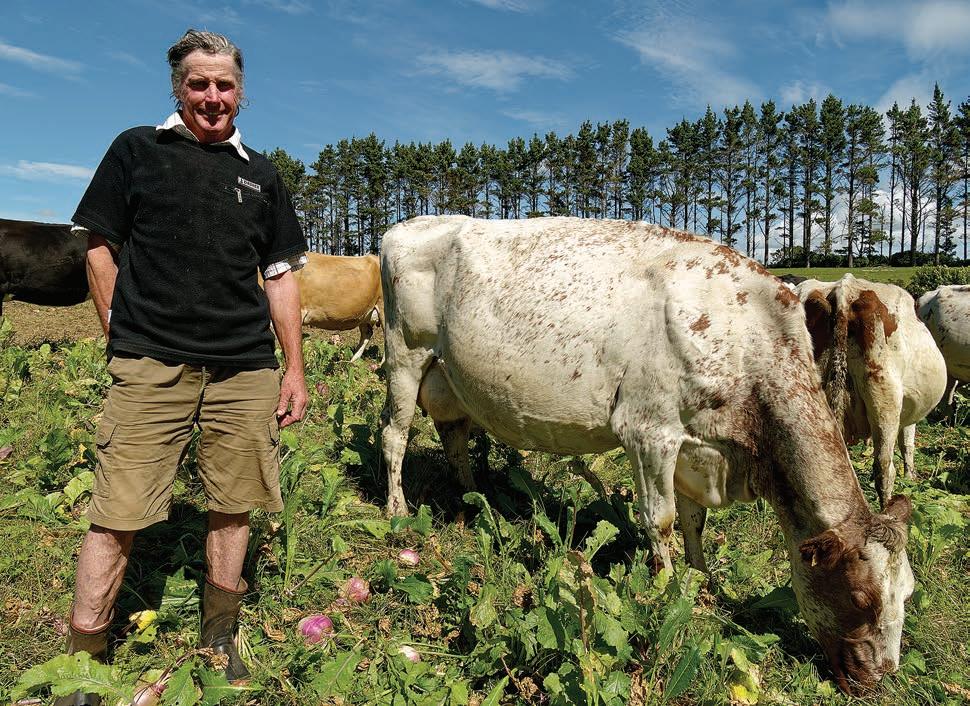
Ross Soffe from Taranaki milks 360 cows, including 90 Milking Shorthorns. The Soffes are aiming to produce around 440kg of milksolids per cow this season. Photos: Ross Nolly
Canada, but because their fat and protein percentages are lower, these are becoming less popular.”
The association sources a large amount of semen from the Scandinavian countries whose cows were predominately based on Shorthorn and Ayrshire breeding. The Scandinavian breeds have very similar components to NZ’s Shorthorn cattle.
“There are reasonable numbers of Shorthorn cattle around the world, but they’ve been bred differently. The Americans and Canadians seem to prefer tall, rangy cows whereas the British prefer a rounded cow. It wasn’t that long ago that the British were still breeding their Shorthorns for dual purpose, with an emphasis on carcase size.” he says.
Ross finds the breeding to be interesting and often quite difficult due to the limited genetic pool. Animals can quite easily become too closely related and it’s important for Shorthorn bull providers to continually seek out-cross bulls.
The predominance of crossbred cattle in NZ makes the Milking Shorthorn a viable option for a three-way cross. Anyone using a Shorthorn for a threeway cross gains a total out-cross option.
“Shorthorns received a bit of a bad rap next product is going to come from,” back in the day when Jerseys came in he says. “Once those breeds are gone, and were crossed with the Shorthorns. they’re gone forever, and so are their Of course they produced great cows, but unique traits and genetics. Who knows they never fully understood the hybrid whether their genetics will be needed in vigour aspect. So they all thought the the future?” Jerseys must be miracle workers. We He believes that having a pet project have quite a few cows that are crossed that doesn’t sacrifice production in the with Shorthorns and they’re very good herd is just another good reason to get cows,” he says. up and go to the shed in the morning.
“There is an old farm saying, ‘There’s But it’s also a way to give back to the never a bad blue cow.’ If you use a white industry and help keep alive the breed Shorthorn bull over Friesian cows, they that started the NZ dairy industry. will produce beautiful blue calves that He has noticed a growing number of grow into very good cows due to their younger farmers becoming interested in crossbred hybrid vigour. the Shorthorn breed.
“A three-way cross works just as As they search for something a little effectively as a two-way cross, because bit different for their herds, they often you’ll still receive the 100% hybrid vigour remark that their grandparents once due to it being a total out-cross,” he says. farmed Shorthorns.
Ross says a South African study “Milking Shorthorns are good sound demonstrated that Shorthorn out- cows with an extremely long history in crosses were just as successful as Friesian NZ,” he says. or Jerseys crosses, and in some cases “They’re good foragers and are out they were better. This study has been eating grass in the rain rather than being supported by more recent US studies tucked up behind the hedges with the using Scandinavian Red dairy breeds. rest of the cows. They’re a good hard-
“Breed diversity is important. Someone working cow and definitely worth a must keep minor and rare breeds going look.” n because you don’t know where the New Zealand Milking Shorthorn Association (Inc)
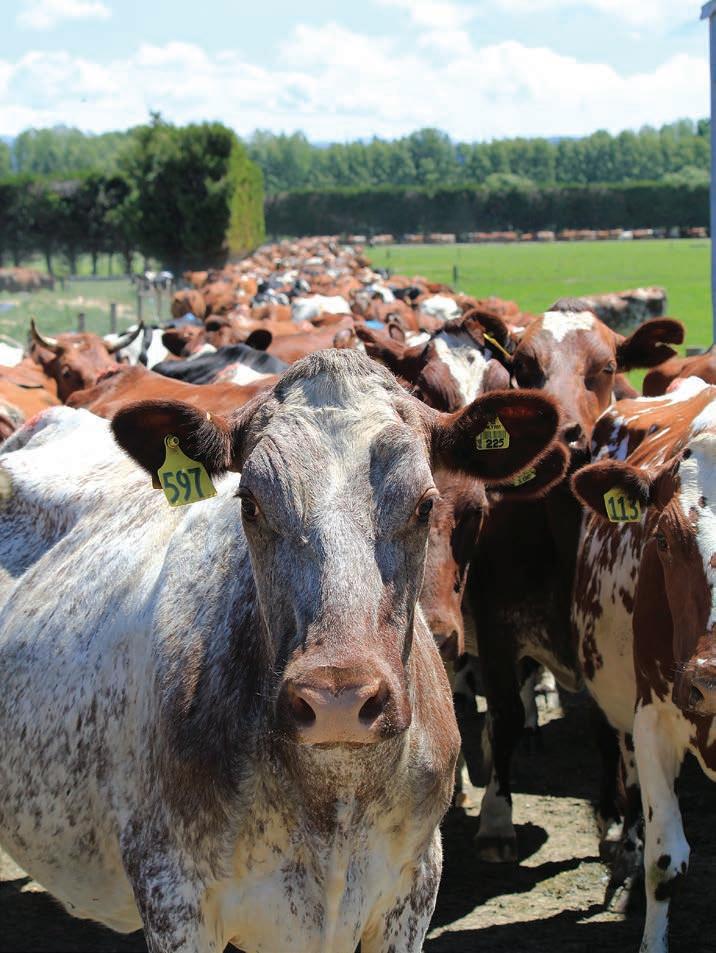
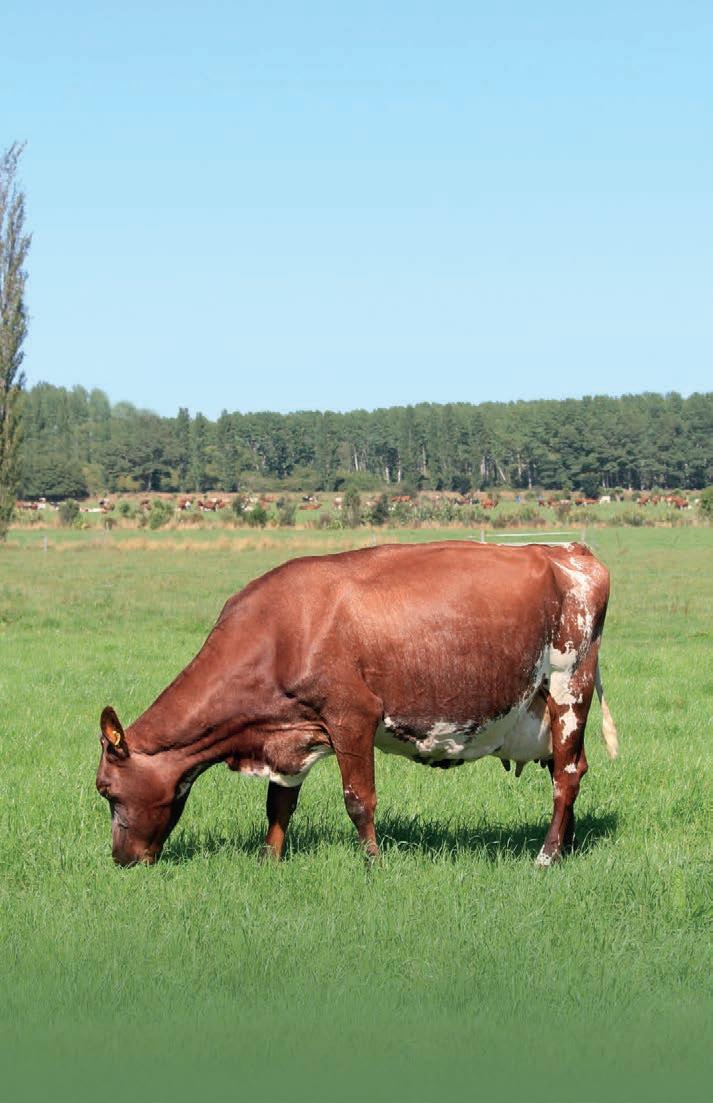
Modern Day Cow
The Dairy Breed For:
- Protein Production - Excellent Legs & Feet - Temperament
- Longevity - Neat Udders - Constitution
- Cross-Breeding - Milking Ability - Fertility
info@nzmikingshorthorn.nz www.nzmilkingshorthorn.nz
Ross Soffe 027 696 4299 soffee@farmside.co.nz FOR ANY ENQUIRIES CONTACT:
David Wood 027 200 2726 david.johanna.wood@gmail.com
Logan Kelly 027 426 5409 logankelly@hotmail.com
Shorthorns were the first cattle breed introduced to New Zealand back in 1814.
Marrying beef and dairy
By Cheyenne Nicholson
A Kellogg report outlines the beef forward marketing concept which would forge a partnership between beef and dairy farmers to create value.
With global demand increasing and farmers struggling to source good quality calves that will finish with a profitable value, Kellogg Rural Leadership alumni Trudy Bensted says a beef forward marketing concept could be the answer.
Beef forward marketing would involve marrying together the dairy and beef industries to form a partnership that benefits everyone in the production chain. Benstead says in this scenario, dairy farmers sell their bobby calves to a calf rearer at 10 days old, who then sells it on to a beef finisher at an agreed price and weight. At finishing, every shareholder would receive a percentage of the profits. Everyone shares the risk and gains to continuously improve, creating a quality product through collaborative planning.
“It’s not a silver bullet fix, it’s about trying to find a system that’s going to be compatible for each farm. While the original idea behind the research was more focused on bobby calves since then, the focus has been on producing higher-quality dairy stock that are able to be finished,” Bensted says.
During her Kellogg report research, beef farmers said they are suffering the consequences of dairy farmers dictating the genetics for the beef industry due to their focus on cost-effective systems and the need for easy-calving animals. While dairy farmers said on-selling beef dairy crosses is hard work with low profit, due to their focus on milk production decreasing the yield in beef carcases.
“Forward marketing agreements are about developing long-term security for dairy farmers, calf rearers and beef finishers to complement each other’s business and smooth out that volatility and risk,” she says.
Some common issues facing farmers when it came to their business included sourcing of low birthweight calves, easy-calving bulls that aren’t too pricey, sexed semen being expensive with unconvincing conception rates and reproduction issues in general, meaning the requirement for replacement heifers is still very much there.
“That’s where my forward marketing beef agreement comes in. It’s implementing that ‘two heads are better than one’,” she says.
Having experienced dairy and beef farmers working together to create a higher genetic merit calf, quality will be driven and bobby numbers decreased. Dual-purpose breeds could also be an option for farmers to introduce genetics that benefits both dairy and beef.
On paper, beef forward marketing contracts between dairy farmers, calf rearers, and beef finishers have substantial merit and while forging relationships between the various parties and hashing out individual agreements would require some work, the question remains – where will these animals go?
Since 1990 dairy farming has taken up almost one million hectares of sheep and beef finishing country, and many have been encouraged over to dairying swayed by more competitive returns. In recent years, sheep and beef farmers are being elbowed out of the high country by increased forestry, further limiting profitable finishing land.
Bensted says that “new generation beef” could be part of the answer. The concept developed and researched by Massey University provides a new avenue to utilise lightweight, yearling steers of dairy origin. Cattle are culled between 10 and 12 months of age, producing small tender cuts of beef.
“Beef farmers seem to be quite excited about new generation beef, they don’t have to carry animals over an extra winter. In saying this, I think a lot of work would need to be done to promote the end product to drive demand and increase the value of that product,” she says.
Bensted says, along with renewed and focused marketing efforts, New Zealand’s grading system and processing plants would need an upgrade to make something like new generation beef an option.
“Upgrades to NZ’s processing, with more automation, will extract more value and offer more feedback and confidence for the producers and information that can further drive their productivity.”
A large percentage of finished beef already comes from dairy origins. Going down the route of beef forward marketing would need some solid leadership and relationship building between industries and individuals, as well as a means by which to connect farmers to forge suitable partnerships.
“I think relationships are one of the biggest issues. There is little trust between dairy and beef farmers, but I see an opportunity for dairy to start taking on leadership and to bring the beef industry into a partnership that drives profits and exports higher while creating more quality in the end product,” she says. n

By working collaboratively, dairy and beef farmers could reduce the number of bobby calves born and produce valuable calves.
Victoria farmer Andrew Delaney has been focusing on herd improvement using top genetics resulting in some of the highest ranking heifers in Australia. Jacqui, Andrew and his dad Ted Delaney with their herd.

Breeding the best
Australian farmer Andrew Delaney isn’t short of replacement heifers.
In fact, he has enough to satisfy his annual herd intake and extras. But it’s one thing to have quantity and something totally different to combine this with quality. He and his wife Jacqui who farm at Nirranda, south west Victoria, have both.
If a trip down the paddock to view their “even” herd of rising two-year-old ABS Jeronimo P heifers – due to calve in mid-September to FB 53 Kenobi Giannis – isn’t proof enough, the genomic data tells an even more impressive story.
In the most recent Australian Breeding Values (ABV) release, in April, the Delaneys not only held the top heifer spot, but they also bred six inside the top 100. These heifers were ranked according to their Balanced Performance Index (BPI) – an economic index which helps dairy farmers independently select sires for their breeding program.
The top heifer was sired by the country’s highest ranked Holstein Jeronimo P and has a BPI$ of 544. Genomic testing results and the BPI underpin most breeding decisions for them and according to Andrew, the data doesn’t lie.
“As soon as I get my genomic numbers back, I work out my good ones and my bad ones, and that gives me my cut off point,” he says.
“I work out my top 40-45 heifers, the ones I want, and then there is a line. Anything below that is gone.
“Even if the animal looks phenomenal and has a beautiful appearance, it’s got to go,” Jacqui adds.
Most recently this “line” was a BPI$ of 310. Anything below that number was sold. To put it in perspective, a BPI$ of 310 places the Delaney heifers among the top 2% of females for BPI in Australia. According to the latest ABV release, the Delaneys’ heifers in the top 100 – including five sired by Jeronimo P and one by Boghill Glamour Persuade – all had a BPI$ of more than 467.
The Delaneys started genomic testing their heifers six years ago. Since then, their average BPI has risen 182% from 110 to 310 BPI$. Underlying their recent herd improvement acceleration has been their focus on selecting young genomic bulls with high BPI rankings and their use of ABS Sexcel™ sexed genetics to deliver more heifer calves.
The story behind the Delaneys’ highflying heifers started when a young genomic bull called ABS Jeronimo P caught Andrew’s attention two years ago. At the time, the bull was fresh from breaking Australian records as the first genomic sire to hit the Australian market with a BPI$ of more than 400.
In April 2021, he was labelled Australia’s highest-ranking sire with a BPI$ of 596 and a Health Weighted Index (HWI) score of 602. For Andrew, the decision to use Jeronimo P as a Sexcel product made both economic and practical sense.
“I was looking for a good type, and a sire with a BPI$ of over 480, he also delivered a bit of width in the rear udder – what we were looking for,” he says.
One of these heifers, bred because of Andrew’s decisions three years ago, is now Australia’s highest BPI heifer. This heifer’s dam was sired by De-Su 12128 Tailor and is one of 40 owned by the Delaney’s due to be mated this month to Bomaz Episode.
The couple along with their children Beau, 11, Jacob, eight, and Amelia, six, farm with Andrew’s parents Ted and Doreen. Ted and Doreen started using artificial insemination more than 50 years ago.
While Andrew is pleased his family has bred the country’s top heifer, he doesn’t focus on individual cows when it comes to herd improvement. Instead, he looks to enhance the whole herd, preferring to lift the average rather than focusing on the odd outlier.
To do this, he mates all heifers and top genomic cows – those cows with a BPI of more than 240 – to Sexcel semen and chooses about three bulls for each mating. Two heifers by short gestation sire De-Su 13530 Seville calved down on their farm in February.
One of these Seville’s has a Production
Index (PI) of 111 was producing 31.3 litres/ day or 2.15kg of milksolids a day. This included 1.13kg of protein and 1.02kg of butterfat. Outside of their highestranking genomic animals, the rest of the milking herd has been mated with conventional semen. But recently Andrew has been weighing up the economics of using ABS Beef InFocus™ dairy-beef semen and making the most of the established supply chain.
“To get a couple of hundred bucks for a beef calf that is a few days old, could work,” he says.
“You don’t have to worry about rearing them.”
Andrew does all his own AI, having previously worked as a technician, and now he’s witnessing first-hand the fertility improvements in his own herd as a result of selecting young genomic, high BPI sires.
One example was during the December mating when he used 50 straws of Episode to mate the first 50 cows on heat and 38 got in-calf. He’s also seen an improvement in the herd’s average bulk milk cell count which, in March, sat at 114,000 cells/ml – despite including 50 “older” cows due to be sold soon.
Last year the Delaneys split calving Holstein herd made the most of favourable seasonal conditions, producing an average per cow production of 8100 litres, 289kg of butterfat and 284kg of protein across an average 305-day lactation.
Andrew has always had an interest in genetics and enjoyed searching for the next avenue for herd improvement. He described breeding as his “hobby”, while Jacqui insisted it was his “passion”.
“He only competes with himself,” Jacqui says about Andrew’s continual quest for herd improvement
“He does what works for his system, the herd is for his benefit.
“I want good cows to work with,” Andrew adds.
“After all, I see them every day, I’m milking them every day.” n
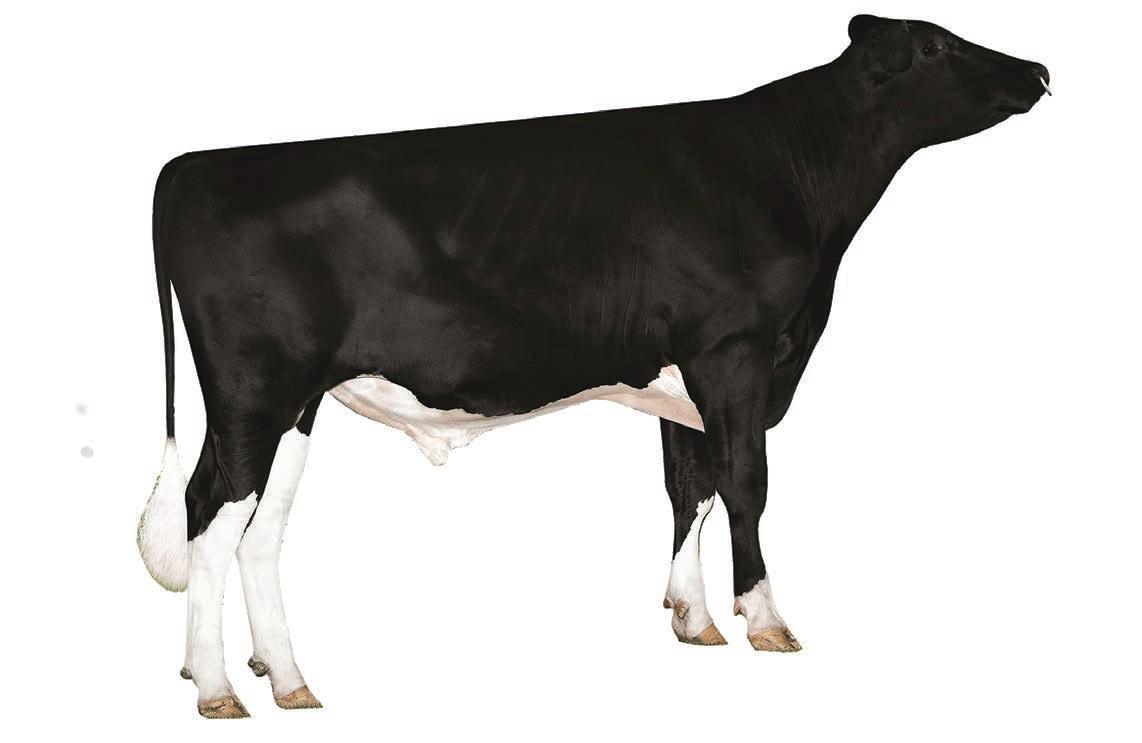
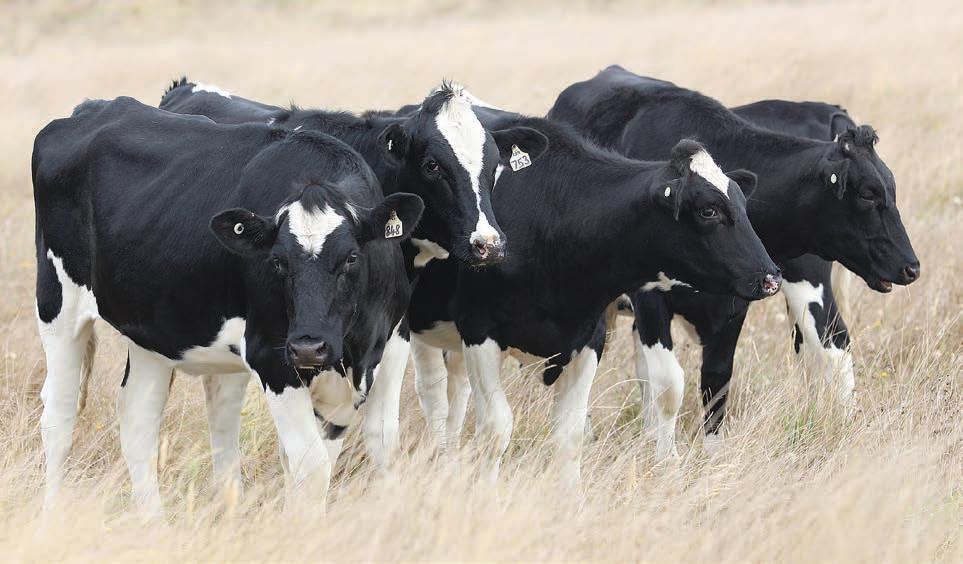
The Delaneys have several animals in the top 100 heifers in the Australian Breeding Values, as well as the number heifer which was sired by Jeronimo P.
In April 2021, Holstein bull Jeronimo P was labelled Australia’s highest-ranking sire. His genetics are available to New Zealand farmers.
MORE:
In New Zealand Jeronimo P is marketed by Samen NZ. He has a range of Homozygous Polled brothers that are showing many of Jeronimo P’s leading traits. In NZ the first Jeronimo P daughters are coming into milk.
Hoof crush Fieldays site – I-19
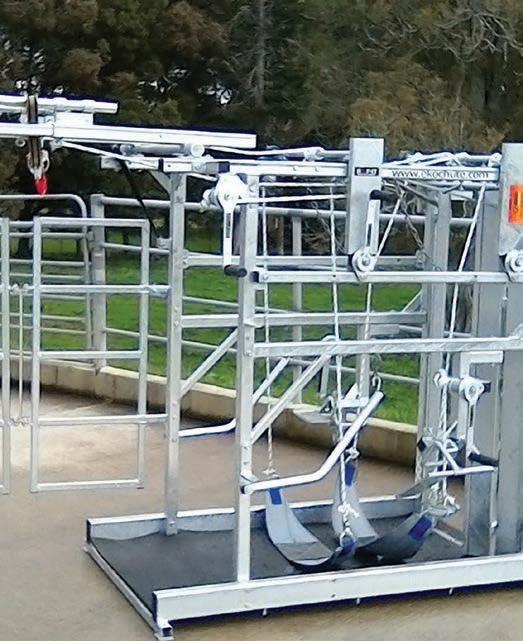
“WE TAKE THE HASSLE OUT OF HOOF CARE”
Prevent and treat lameness issues in your herd.
• Lame Cows or Bulls • Pre-mating Blocking of Bulls • Tidy-up and rebalance trims • Small and large herds • Fast, thorough and efficient • Low cost Pre-booking essential.
Balanced
Range of Hoof Care products available at www.hoofit.nz
One last word …
It has been a busy month on-farm as the season starts to wind down.
The harvesting is done and safely stored away, ready to be fed when growth stalls during the colder months.
Many farmers are well into drying off their herds and sending stock to run-offs or graziers over winter. Of course, our autumn calving farmers are gearing up to keep the white gold flowing through the winter.
And even with the season winding down for the majority of farmers, there is still lots to be done – a farmer’s work is never done.
Sharemilkers are well into preparations to shift farms but by the looks of it, if social media is anything to go by, there does not appear to be as many making the shift between farms as in previous years.
I am picking this is a hangover of covid and the lack of skilled staff available.
A DairyNZ staff shortage survey conducted recently shows of the 1148 responses, 49% reported staff shortages and of that figure, 24% have been shortstaffed for six months or more, and 58% of respondents reported increased stress levels.
Overall, 87% said they have made improvements to employment conditions of that figure, 25% of farmers said they have made it easier to recruit staff, and 60% said they have made it easier to retain staff, while 65% said they have increased salary and wages.
However, now that the travel bubble with Australia has kicked in, 1000-1300 beds each fortnight will be freed up in
MIQ. The lack of space in MIQ facilities has often been the excuse as to why skilled immigrant workers have not been allowed back into the country, but now there is no excuse.
The Government should move immediately to ensure skilled migrants are allowed back in; we have already seen the effects of the lack of workers in orchards where thousands of apples have rotted on the ground.
Meanwhile, most farmers I have spoken with have been pretty happy with how the season has gone.
Fonterra’s interim results were good, dairy prices are holding steady for now and Mother Nature is playing ball.
The only big spanners in the works are the Climate Change Commission recommendations and the Government’s announcement it intends to phase out live exports. Both of these will have farreaching implications for our farmers and only time will tell how they play out.
Thanks to Danny Wano from Taupo for this months’ photo. Danny is an assistant manager on an 1100-cow farm with four crew and one full-time casual staff member. He is known as the joker of the pack as he loves to see the crew happy and is always making them laugh. He says he took a dozen photos that morning and each one was better than the last.
Have fun guys. Sonita Like us: farmersweekly.co.nz Follow us: @DairyFarmer15 Read us anywhere: farmersweekly.co.nz
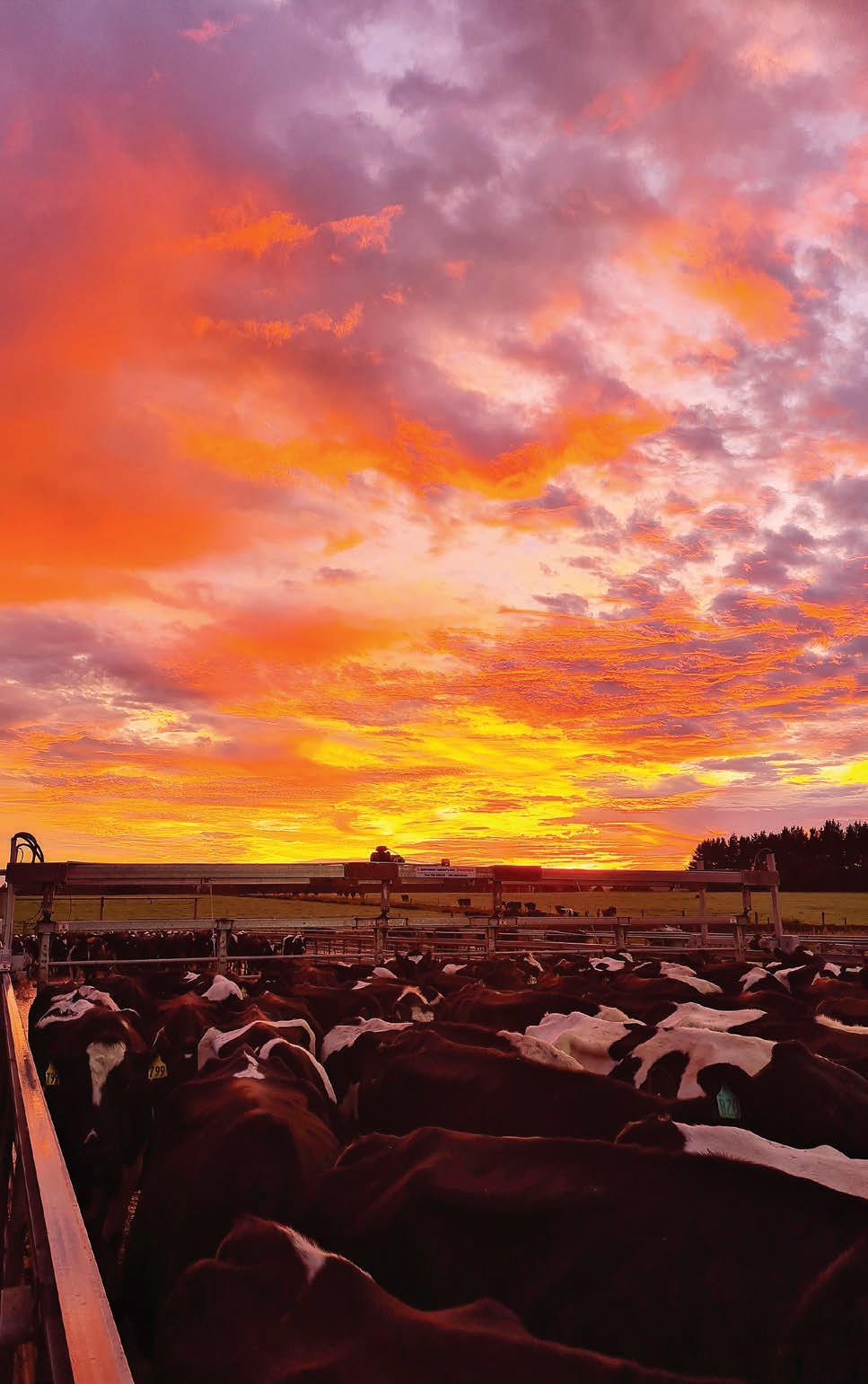
Dairy Diary
May 2021
May 5 – DairyNZ
Workplace360 is a work environment and leadership assessment tool, designed to help you be the proud owner of a great workplace. Join our fortnightly Zoom meeting to find out more about this tool and have your questions answered by our DairyNZ expert Jane Muir. Info at www.dairyevents.co.nz
May 6 – DairyNZ
MilkSmart is all about increasing milking efficiency on the farm, resulting in benefits for farm staff and the cows. Debbie McCallum and the team at DTT Gibson Farm will be hosting us for the day in Taranaki, as they are keen to improve their milking times and milking efficiency. Info at www.dairyevents.co.nz
May 6 – DairyNZ
Waikato Autumn Calving Group will focus on the host farm’s system and seasonally relevant topics. It is an open forum that utilises the experience of all members in the group. Info at www.dairyevents.co.nz
May 6 – DairyNZ, Webinar 1
In May, all farmers nationwide will be able to join two interactive DairyNZ Farmers’ Forum webinars, showcasing the forum’s economic insights and scientific solutions. Join DairyNZ’s economics team for insights into the competitiveness of NZ’s dairy sector against key international competitors, and a discussion on how we can develop and refine our systems to maintain competitiveness and performance. Info at www.dairyevents.co.nz
May 11 – AgResearch
Come along to the AgResearch seminars in Invercargill, supported by MPI, to hear the latest science and information on winter grazing. Topics covered will include animal welfare, health and nutrition, as well as looking at the environmental aspects of winter grazing. The free one-day seminar is for rural professionals. Farm consultants, veterinarians and rural advisers can register by emailing slu.team@mpi.govt.nz before May 5. Registration is essential.
May 11 – DairyNZ
Learn about the Waikeria farms and the agricultural training that the prisoners are receiving at Waikeria Prison Farm Field Day. It’s a chance to introduce the idea of farmers employing a prisoner and the options on how this could be done, and the support they will receive. To secure a place on this field trip, please RSVP to Sam Jenkins by emailing sam.jenkins@dairynz.co.nz
May 13 – DairyNZ
Bring your farm team to Practical Farm Safety Field Day in Shannon. Join us on-farm as we learn more about machinery and how to use it safely. This is a great opportunity to refresh/ upskill your team. Info at www.dairyevents.co.nz
May 13 – Lincoln University
Lincoln University Dairy Demonstration Farm (LUDF) Focus Days are aimed at dairy farmers – owners, managers and staff – and dairy industry professionals, who are invited to come along and hear about what we are doing, with season to-date performance and research and development updates. Info at http://www.siddc.org.nz/lu-dairy-farm/
May 13 – DairyNZ, Webinar 2
DairyNZ research to help farmers be globally competitive, locally responsible and resilient to regional challenges. Join the DairyNZ Farmers’ Forum discussion with DairyNZ’s science team about the latest science-based solutions to farming challenges. Info at www.dairyevents.co.nz
May 19 – DairyNZ
Come and see what Jared Whitfield is achieving in Moutoa at the Foxton-Moutoa Field Day. Join us on-farm, where we’ll discuss his farm’s system and management practices to identify opportunities and solutions that meet the host’s future goals and objectives. We will also discuss seasonal issues and challenges that are affecting farmers in the region. Info at www.dairyevents.co.nz
May 26 – Dairy Trust Taranaki
What does our future farm system look like? Dairy Trust Taranaki are trialling this. DTT has partnered with DairyNZ to run a Step Change programme to create change on Taranaki Dairy Farms, with respect to increased profit, lower methane output and lower N surplus. Come and see the results from the first year of the trust’s latest trial at the Gibson Farm: Step Change Open Day. Info at www.dairytrusttaranaki.co.nz/dtt-gibson/
May – LIC
MINDA Roadshow, Various dates and locations. LIC will be hitting the road until July, holding free MINDA LIVE and MINDA app training sessions as well as a Protrack session to show you how to get more out of your Protrack system’s software from MINDA LIVE. Info at www.events.humanitix.com/tours/minda-roadshow-2021







